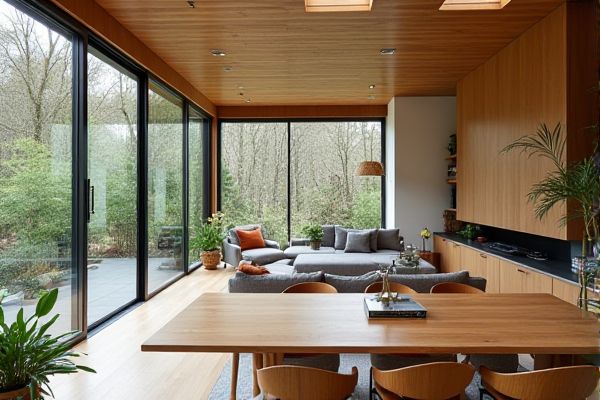
Open concept sunrooms create a seamless flow with your indoor living spaces, maximizing natural light and enhancing spaciousness, while partitioned sunrooms offer designated areas for privacy and tailored functionality. Explore the rest of the article to determine which sunroom design best suits your lifestyle and home needs.
Table of Comparison
| Feature | Open Concept Sunroom | Partitioned Sunroom |
|---|---|---|
| Layout | Continuous, spacious area without walls | Divided into sections with partitions or walls |
| Privacy | Low privacy, open visibility | High privacy with separated zones |
| Flexibility | Flexible use of space, adaptable for various activities | Designated areas for specific functions |
| Natural Light | Maximized light flow throughout space | Light may be reduced in partitioned sections |
| Noise Control | Limited noise reduction due to open plan | Better sound insulation between areas |
| Cost | Typically lower cost, simpler construction | Higher cost due to added walls and materials |
| Maintenance | Easy to clean and maintain | More surfaces and corners to maintain |
| Use Case | Ideal for social gatherings, large activities | Suitable for multi-use functions requiring separation |
Introduction to Sunroom Design Concepts
Sunroom design concepts vary primarily between open concept and partitioned layouts, each offering unique benefits tailored to your living needs. Open concept sunrooms maximize natural light and create a seamless flow between indoor and outdoor spaces, ideal for entertaining or relaxation. Partitioned sunrooms provide distinct zones for privacy and functionality, allowing you to customize the space for specific activities while maintaining comfort year-round.
What Is an Open Concept Sunroom?
An open concept sunroom features minimal interior walls, creating a seamless flow between the sunroom and adjacent living spaces, maximizing natural light and enhancing the sense of spaciousness. This design emphasizes large windows and open layouts to integrate indoor and outdoor environments effectively. Open concept sunrooms are ideal for homeowners seeking a bright, airy atmosphere with unobstructed views and flexible use of space.
Defining a Partitioned Sunroom
A partitioned sunroom is defined by its use of interior walls or dividers to create separate zones within the space, offering privacy and distinct functional areas. Unlike open concept sunrooms, partitioned designs provide better control over temperature and noise, enhancing comfort for your activities. This approach allows for tailored decoration and use without sacrificing the natural light that sunrooms are known for.
Aesthetic Appeal: Open vs Partitioned Sunrooms
Open concept sunrooms offer a seamless, airy aesthetic that maximizes natural light and creates a spacious feel, enhancing your home's connection to the outdoors. Partitioned sunrooms, with defined walls or glass dividers, provide a cozy, structured ambiance while allowing versatile design elements and privacy. Choosing between these styles depends on whether you prefer expansive openness or distinct, functional spaces tailored to your lifestyle.
Natural Light and Ventilation Considerations
Open concept sunrooms maximize natural light by eliminating barriers, allowing sunlight to flow freely throughout the space and enhancing ventilation with unobstructed airflow. Partitioned sunrooms create distinct zones that can limit both light penetration and air circulation but offer customizable control over temperature and privacy. Your choice should balance the desire for bright, breezy interiors with specific needs for separation and climate control.
Space Utilization and Functionality
Open concept sunrooms maximize space utilization by eliminating walls, creating a seamless flow between indoor and outdoor areas that enhances natural light and allows for flexible furniture arrangements. Partitioned sunrooms offer defined zones that improve functionality by providing privacy, reducing noise, and enabling specialized uses such as reading nooks or dining areas. Choosing between open concept and partitioned designs depends on whether the priority is an expansive, airy feel or segmented, purpose-driven space utilization.
Privacy and Noise Control Comparison
Open concept sunrooms offer a spacious feel but provide limited privacy and minimal noise control, allowing sounds to travel freely within connected living areas. Partitioned sunrooms use walls or glass dividers to create distinct zones, enhancing privacy and significantly reducing noise transmission. Your choice depends on whether you prioritize a seamless flow or a quieter, more private retreat.
Energy Efficiency and Climate Control
Open concept sunrooms typically have larger, uninterrupted glass surfaces, which can lead to higher heat gain during summer and greater heat loss in winter, impacting energy efficiency negatively. Partitioned sunrooms allow for better climate control by isolating different sections, reducing overall heat transfer and enabling targeted heating or cooling. Energy-efficient window treatments, insulated partitions, and HVAC zoning in partitioned sunrooms enhance temperature regulation and reduce utility costs compared to open concept designs.
Cost Factors and Installation
Open concept sunrooms typically have lower installation costs due to fewer structural requirements and simpler framing, while partitioned sunrooms demand higher expenses for additional walls, doors, and privacy features. Cost factors for partitioned designs include extra materials, HVAC zoning, and labor to construct separate areas, impacting the overall budget significantly. Installation time for partitioned sunrooms is longer, as precise measurements and customized components are necessary to accommodate partitions without compromising insulation and natural light.
Choosing the Right Sunroom Style for Your Home
Choosing the right sunroom style depends on your home's layout and how you intend to use the space. Open concept sunrooms create a seamless flow between indoor and outdoor areas, maximizing natural light and providing a spacious feel, ideal for entertaining. Partitioned sunrooms offer defined zones that enhance privacy and flexibility, making them suitable for separate activities or seasonal use.
 homyna.com
homyna.com